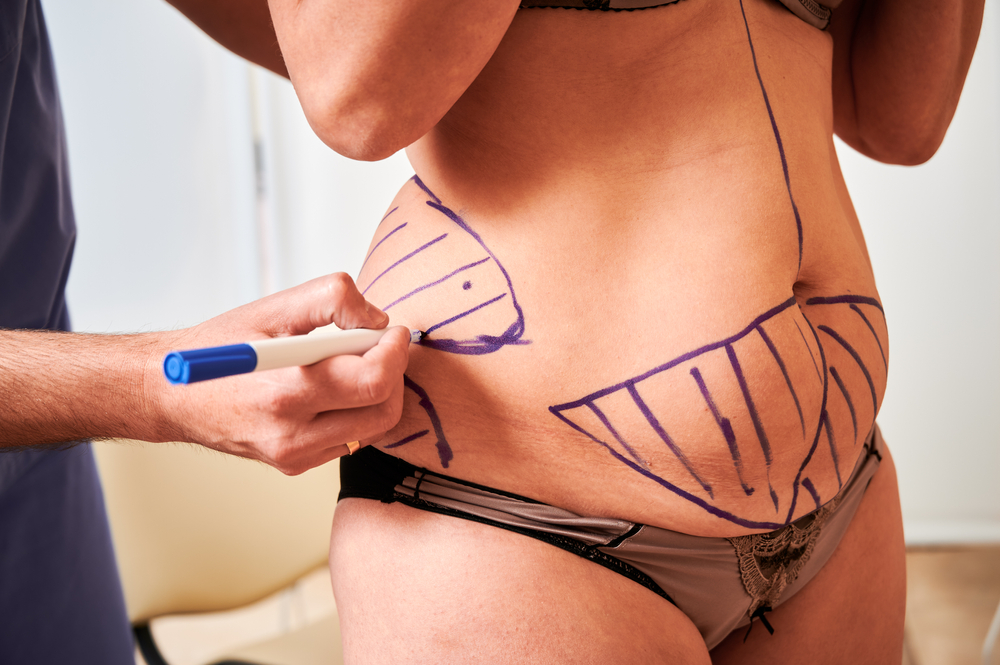A tummy tuck, also commonly referred to as “abdominoplasty,” is a cosmetic surgical procedure to improve the shape and appearance of the abdomen.
During a tummy tuck, excess skin and fat are removed from the abdomen. The abdominal muscles (or fascia) are commonly tightened with sutures. The remaining skin is then repositioned to create a more tight, toned and youthful look.
You might opt for a tummy tuck if you have excess skin and fat around the area of your belly button or a weak lower abdominal wall. A tummy tuck does have the ability to enhance the way you look. Before we jump into all the specifics, let’s discuss why someone would consider a tummy tuck procedure.
Table of Contents
ToggleWhy Get Tummy Tuck Surgery?
There are several reasons you might have excess fat, poor elasticity of the skin or weakened connective tissue in your abdomen. These include:
- Pregnancy
- Weight loss
- Prior abdominal surgery (C-section for example)
- Aging
- Poor genetics
A tummy tuck can eliminate loose, excess skin and fat while tightening weakened and separated fascia (rectus diastasis). It can also remove stretch marks. However, it is important to note that a tummy tuck cannot correct stretch marks beyond the immediate abdominal wall.
If you’ve had a C-section in the past, your plastic surgeon can usually remove an existing C-section scar during a tummy tuck.
A tummy tuck can also be done in combination with other body contouring cosmetic procedures, such as breast surgery. If you’ve had fat removed from your abdomen (liposuction), you may decide to have a tummy tuck because liposuction does not address loose skin.
A tummy tuck isn’t for everyone. Your doctor might caution against a tummy tuck if you:
- Planning to get pregnant in the future
- Planning to lose a large amount of weight
- If you have a severe chronic condition (Ex. heart disease, diabetes)
- If your body mass index is 30 or higher
- If you smoke (both marijuana and tobacco)
- If you’ve had previous abdominal surgery that caused significant scar tissue
What Type Of Risks Does This Surgery Have?
Just like with any plastic surgery, a tummy tuck procedure does pose various risks, including:
- Tissue damage: During a tummy tuck, the blood supply of the abdominal tissues is damaged and can in rare instances “necrose” and die. Smoking heightens the risk of tissue damage or necrosis. The healing of tissues in the affected area may occur naturally with good wound care or necessitate a supplementary surgical procedure based on the size of the region.
- Fluid collection (seroma): To prevent excess fluid accumulation, drainage tubes are typically required post-surgery. Your physician may also extract fluid post-surgery through aspiration with a needle and syringe.
- Altered Skin Sensation: Throughout a tummy tuck procedure, the rearrangement of abdominal tissues impacts the nerves in the abdominal region and occasionally in the upper thighs. It’s common to experience decreased sensation or numbness, which typically improves in the months following the surgery but can be permanent.
- Poor wound healing: It’s possible that you may experience poor healing along the incision line. This is counteracted using medical grade scar care products.
- Unexpected scarring: Your incision scar from your tummy tuck will be permanent, but it’s usually placed along the easily hidden bikini line. The length and visibility of the scar will vary from person to person but genetics can and does play a role what’s the formation of hypertrophic or keloid scarring.
Like any other type of major surgery, a tummy tuck also poses a risk of bleeding, infection and adverse reactions to anesthesia.
How To Prepare For Tummy Tuck Surgery
Schedule a consultation with an actual plastic surgeon (and not a patient coordinator). During that first visit, your plastic surgeon will likely:
- Discuss your expectations: You’ll get an opportunity to discuss your tummy tuck surgery with your plastic surgeon. Here, you’ll have an opportunity to explain why you want a tummy tuck, and what you’re hoping for in terms of appearance after the procedure. Ensure you comprehend the advantages and potential drawbacks of the procedure, such as scarring. Remember that past abdominal surgeries could impact the outcome.
- Review your medical history: Prepare to discuss your current and previous medical conditions. Mention any medications you are currently taking or have taken recently, along with any past surgeries. Inform your doctor about any allergies to medications you may have. If your interest in a tummy tuck is due to weight loss, expect your doctor to inquire about your weight fluctuations in detail.
- Physical exam: To have the ability to weigh out all your treatment options, the surgeon will examine your abdomen. The doctor might also take pictures of your abdomen for your medical record.
Before a tummy tuck you might also need to:
- Maintain a stable weight: Keeping a stable weight for at least 12 months before having a tummy tuck is often recommended. If you are significantly overweight, your doctor may advise weight loss prior to the procedure. Substantial weight loss post-procedure could impact your results.
- Stop smoking: Smoking reduces skin blood flow, hindering the healing process and raising the chance of tissue damage. If you smoke, your doctor will advise quitting before and after surgery to support recovery.
- Avoid certain medications: It’s advisable to steer clear of aspirin, anti-inflammatory medications, and herbal supplements as they may heighten the risk of bleeding.
- Arrange for help during recovery: You will need help in the early days of your recovery. Be sure to plan for someone to drive you to and from surgery home. Likewise, you will need a chaperone for at least a week as you will be vulnerable during that time.
What Can You Expect?
Tummy tuck surgery can be performed in a few different locations. A tummy tuck can be done in an hospital, outpatient surgical facility, or plastic surgery office. During a tummy tuck, you’ll be under general anesthesia. General anesthesia makes you completely unconscious and unable to feel pain. In some cases, you might be given pain-relieving medication and be moderately sedated (partially asleep).
What You Should Know Before Your Surgery
There are several different types of tummy tuck, depending on your anatomy, tissue damage and aesthetic goals.
In a standard procedure, the plastic surgeon creates incisions to eliminate excess skin and fat in an elliptical shape between your belly button and pubic area. The connective tissue (fascia) covering the abdominal muscles is subsequently tightened using permanent sutures if there is a diastasis or separation caused by pregnancy.
The amount of excess skin that will need to be removed and the type of procedure you have will be the determining factor that determines the length and type of incisions used. The incision is typically placed just above the pubic hairline from hip bone to hip bone and should leave a scar that falls along a natural crease within the bikini line. In this way, it’s hidden as much as possible.
Your plastic surgeon will also reposition the skin around your belly button. Your bellybutton will be brought out through a small incision and sutured in its normal position.
How Long Does This Surgery Last?
A tummy tuck produces permanent results. However, aging still occurs and the skin will loosen over time. Touchup procedures can sometimes be necessary many years after the original surgery. You also need to adjust your lifestyle to optomize the results, including a clean and green diet and exercise. Weight fluctuations in particular can damage the result over time.
If you’re wondering how long tummy tuck surgery lasts, the procedure typically takes about two to four hours to complete. Some of this depends on the size of the patient, the extent of the incisions and whether ancillary procedures, such as liposuction, are performed.
How Many Weight Sizes Do You Lose With A Tummy Tuck?
Typically, patients undergoing tummy tuck surgery may see a reduction of around 2 to 3 pant sizes, with some achieving even greater waistline reductions. The outcome is influenced by the initial amount of excess skin and the patient’s dedication to post-surgery weight maintenance.
Is Tummy Tuck Surgery Painful?
At the beginning, you will be fatigued, swollen and sore. It is normal to have moderate pain during these first few days, although this will improve as you get further from your surgery date. It is vital to allow yourself time to focus on rest and healing, you need a few days to get closer to normal. If you’re having pain weeks or months later, you need to call your doctor immediately.
How To Find The Right Tummy Tuck Plastic Surgeon?
Before you reach out to anyone, make sure you take the time to do your research. Go to Google and start your research for a plastic surgeon experienced with body contouring procedures such as this one. A great plastic surgeon will have patient reviews you can read for yourself.
It is critical to also carefully review before and after tummy tuck pictures. You definitely want to make sure your surgeon is board certified.
What You Should Know After Your Surgery
Following a tummy tuck, your abdominal incision and belly button will typically be shielded with surgical dressing. Tiny tubes may also be inserted along the incision area to remove any surplus blood or fluid.
The plastic surgery center staff or members of your health care team will help you walk as early as the first day after surgery to help prevent the formation of blood clots.
During this time, it’s likely you’re going to have swelling, soreness, bruising, and pain. Due to this, the plastic surgeon will probably prescribe pain medication to help with the discomfort. Just know that it’s normal to have swelling in the surgical area which can persist for months.
After surgery, drainage tubes may remain for several days. Your healthcare provider will demonstrate how to empty and maintain the drains. It’s possible that you’ll need to keep taking antibiotics for as long as the drains are in use.
Your surgeon might also prescribe a blood-thinning medication for a short time after your tummy tuck based on your personal and family medical history.
You’ll wear a supportive abdominal compression garment specifically designed for abdominoplasty for a minimum of six weeks. This helps prevent fluid buildup and provides abdominal support while you heal and optimizes, subsequent contour. Your doctor will explain how to care for your scar.
During the initial six weeks following your surgery, it is crucial to move cautiously and avoid positions that could strain your incision line. This includes refraining from sudden bending at the waist to minimize the risk of wound reopening minimizing strenuous lifting.
You’ll need to schedule regular follow-up visits. Ask your doctor how often you need to be seen.
What Type Of Results Should I Expect?
By removing excess skin and fat and strengthening your abdominal wall, a tummy tuck can give your abdomen a more toned and slimmer appearance.
Tummy tuck results are usually long lasting if you maintain a stable weight.
If you’re interested in tummy tuck surgery, be sure to reach out to our Charlotte plastic surgery and skin center.










